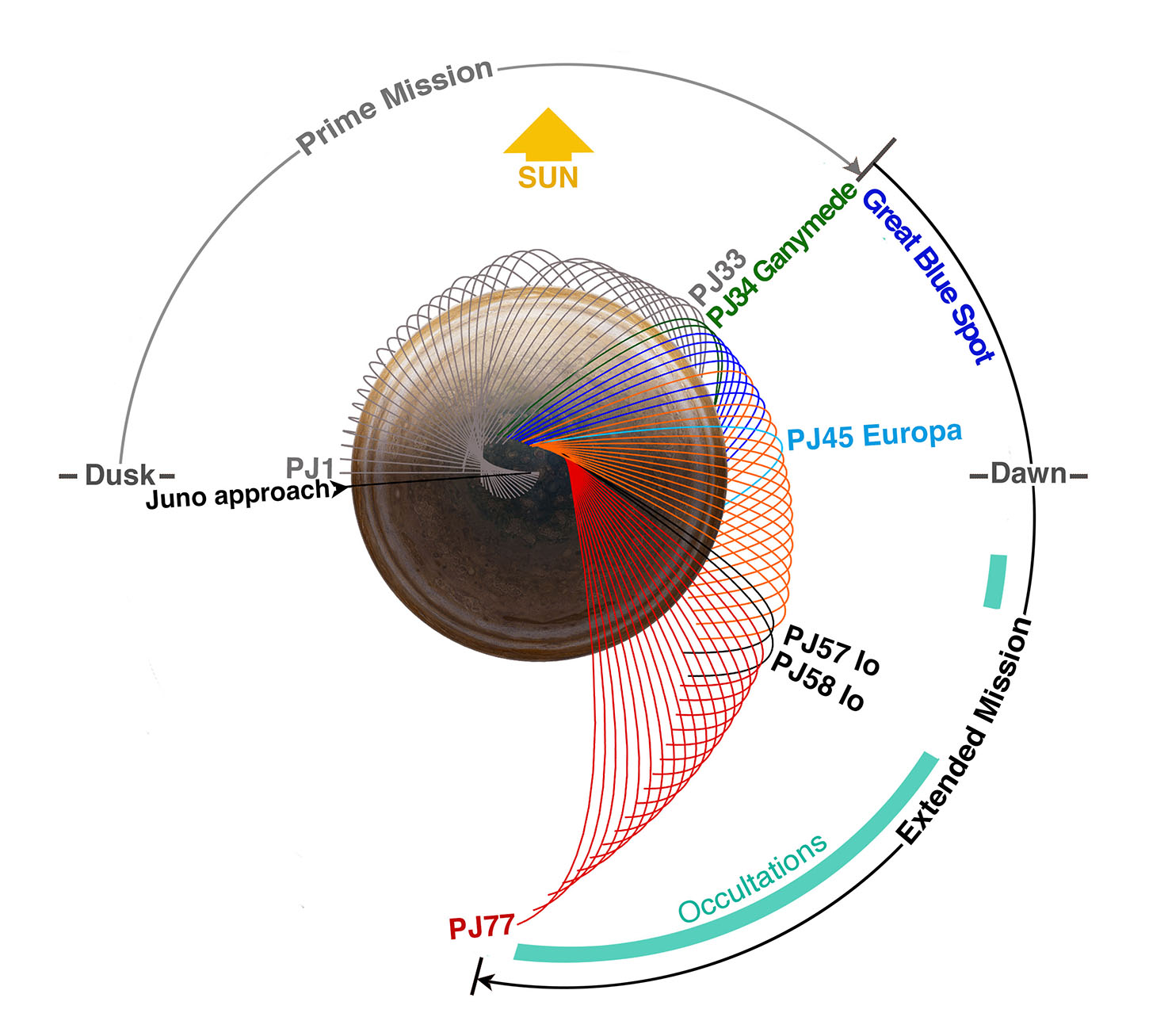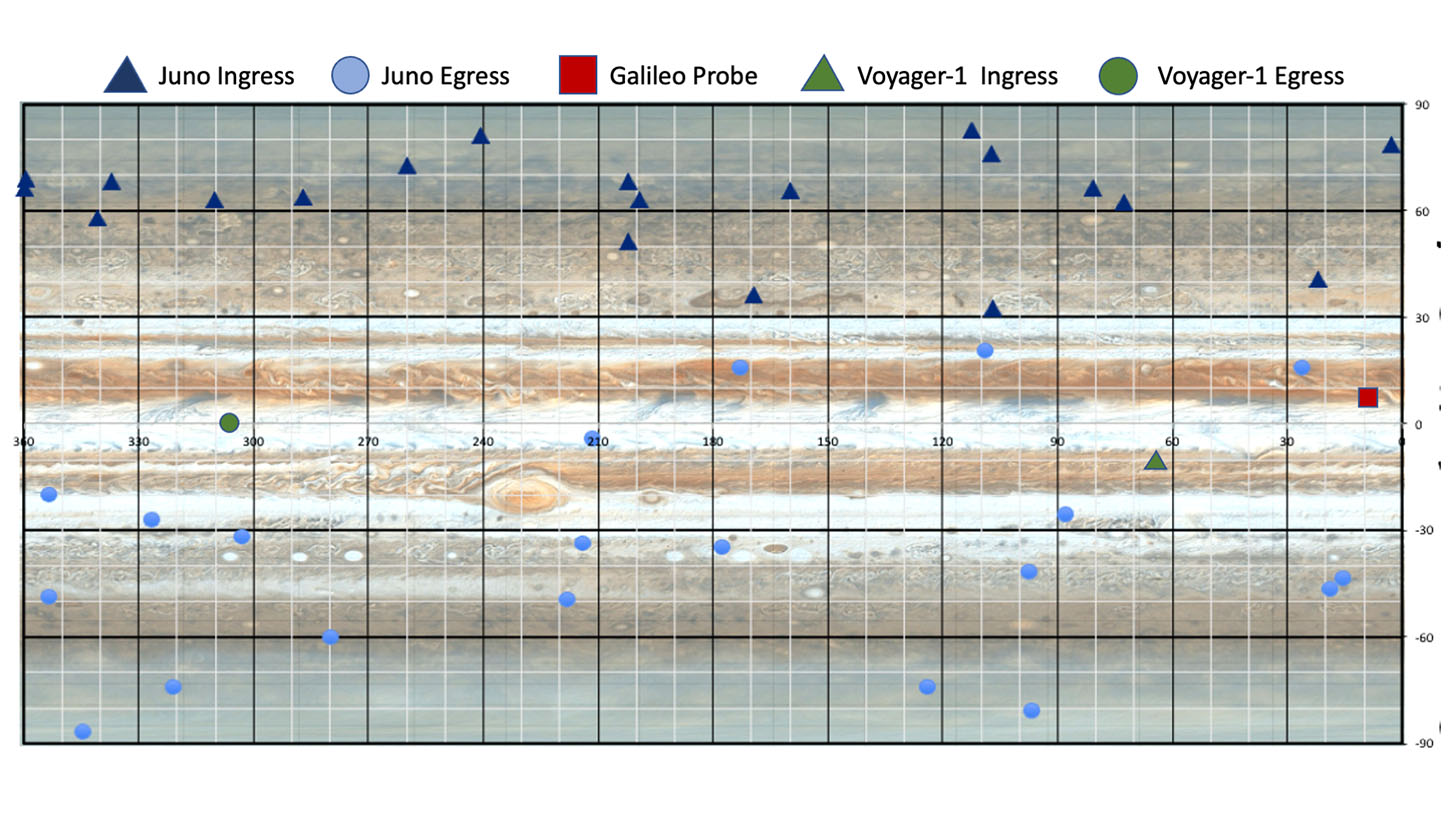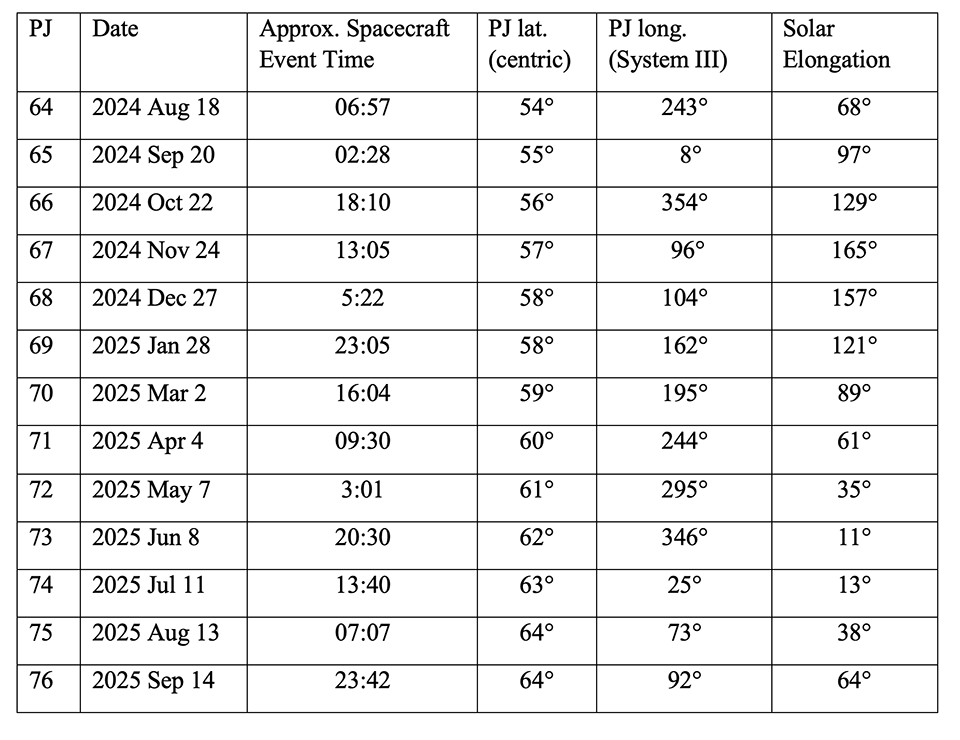The Juno Extended Mission: A Final Call for Continued Support from Amateur Observers
- 1Jet Propulsion Laboratory, Pasadena, California, United State of America (glenn.orton@jpl.nasa.gov)
- 2British Astronomical Association, London, UK
- 3Michigan Technological University, Houghton, MI, USA
- 4Planetary Science Insitute, Tucson, AZ, USA
- 5Southwest Research Institute, San Antonio, TX, USA
- 6University of Leicester, Leicester, UK
Introduction
The extended portion of NASA’s Juno mission began on 1 August 2021 and will continue through September 2025, after which the mission is not expected to continue providing useful observations, due to a combination of fuel exhaustion and radiation damage. In the meantime, the extended mission is successfully expanding Juno’s science goals beyond those of the prime mission, as noted previously by Orton et al. (2021, 2022, 2023). Atmospheric studies will continue to be among Juno’s science goals and an area in which the world-wide community of Jupiter observers can provide significant contextual support. Juno’s remote-sensing observations will take advantage of the migration of its closest approaches (“perijoves” or PJs) toward increasingly northern latitudes. The observations include close-ups of the circumpolar cyclones and semi-chaotic cyclones known as “folded filamentary regions”. A series of radio occultations are providing vertical profiles of electron density and the neutral-atmospheric temperature over several atmospheric regions. The mission can also characterize the variability of lightning on Jupiter’s night side.
Physical Details of the Mission
The sequence of orbits and key investigations of the primary and extended missions are shown in Figure 1. We note that on PJ34, the orbital period was reduced from 53 days to 43-44 days. It was further reduced on PJ45 to 38 days and reduced again on PJ57 to ~33 days. Some characteristics of perijoves of the extended mission are shown in Table 1. We caution that while the day of year for the perijoves is reasonably fixed, the exact times may change.
Role of Amateur Astronomers
We’ve noted at previous EPSC and EPSC-DPS meetings how the amateur community can contribute to the Juno mission via their collective world-wide 24/7 coverage of Jupiter. This applies also to the cadre of professional astronomers supporting the Juno mission and its reconnaissance of the Jupiter system over a broad spectral range. For example, this community have provided the context of different regions over which Juno’s Microwave Radiometer (MWR) has sensed plumes and “hot spots” (Fletcher et al. 2020). They have also alerted observers to strong interactions between the Great Red Spot and smaller anticyclones (Sanchez-Lavega et al. 2021) and the occurrence and evolution of prominent and unusual vortices, such as “Clyde’s spot” (Hueso et al. 2022). More recently, observations were made with the NASA Infrared Telescope Facility (IRTF) that showed slow-moving bright patches in the Equatorial Zone (EZ) that were observed more continuously among the amateur community with 890-nm (“methane”) filters. The continued tracking of outbreaks in the southern part of the North Equatorial Belt (NEB) also greatly informed the Juno team and supporting astronomers regarding the systematic longitudinal distribution of outbreaks and the range of atmospheric features they generate. A perijove-by-perijove summary of Juno-supporting observations – past, current and planned - is available at the following web site: https://www.missionjuno.swri.edu/planned-observations.
We emphasize that after PJ50, Juno’s perijoves migrated to the nightside. From now through the end of the mission, images from this community will be extremely useful to provide a context for several investigations. One of these will be high on JunoCam’s agenda during this part of the mission: searches for lightning. But similar contextual information will be sought for measurements of thermal emission from the JIRAM instrument’s high-resolution maps of 5-µm emission, as well as the MWR measurements of thermal emission from the deep atmosphere. Although the highest spatial resolution from these instruments will include high northern latitudes (see Table 1) that are not well resolved by small telescopes, measurements of mid-northern latitudes will continue to be made in the absence of close-up JunoCam images. The JunoCam images will not be able to provide a visual context, except from a distance with worse spatial resolution than is possible from the amateur community. Besides the mid-northern latitudes, observations from the amateur community will also provide the visible-wavelength context for anticipated continuation of JIRAM’s 5-µm maps of much of the southern hemisphere.
Some of this research was carried out at the Jet Propulsion Laboratory, California Institute of Technology, under a contract with the National Aeronautics and Space Administration (80NM0018D0004).
References
Fletcher et al. 2020. J. Geophys. Res. 125, 306399.
Hueso et al. 2022. Icarus 380,114994
Orton et al. 2021. EPSC2021-58. doi: 10.5194/epsc02921-58.
Orton et al. 2022. EPSC2022-769. doi: 10.5194/epsc2022-769.
Orton et al. 2023. DPS. id. 115.01. Bull. Amer. Astron. Soc. 55, e-id 2023n8i115p01.
Sanchez-Lavega et al. 2021. J. Geophys. Res. 126, e006686.

Figure 1. Progression of Juno orbits viewed from above Jupiter’s north pole with respect to local time of day. “PJ” designates a “perijove”, the closest approach to Jupiter on each numbered orbit. Following a Ganymede flyby on PJ34 (green orbit), the orbital period decreased from 53 days to 43-44 days (green + blue orbits). The “Great Blue Spot” (blue) orbits map an isolated patch of intense magnetic field. Following a close Europa flyby on PJ45 (aqua orbit), the period decreased to 38 days (orange orbits). Following close flybys of Io on PJ57 and PJ58 (black orbits) the period decreased to 33 days (red orbits). In reflected sunlight, Jupiter mostly appears as a crescent at perijoves following PJ58.

Figure 2. Latitudes and longitudes to be measured by the 20 radio occultations of the Juno spacecraft between PJ52 and PJ77. Locations of ingress lie largely in the northern hemisphere - locations of egress in the southern hemisphere. Locations of the Galileo Probe and Voyager-1 radio occultations are also shown for reference.
Table 1. Current estimates of perijove properties for the remainder of Juno’s extended mission: PJ64-PJ76. Information for previous perijoves and a summary of proposed, planned and executed observations at large telescopes is listed in: https://www.missionjuno.swri.edu/planned-observations.

How to cite: Orton, G., Rogers, J., Momary, T., Brueshaber, S., Hansen, C., Bolton, S., and Fletcher, L.: The Juno Extended Mission: A Final Call for Continued Support from Amateur Observers, Europlanet Science Congress 2024, Berlin, Germany, 8–13 Sep 2024, EPSC2024-134, https://doi.org/10.5194/epsc2024-134, 2024.